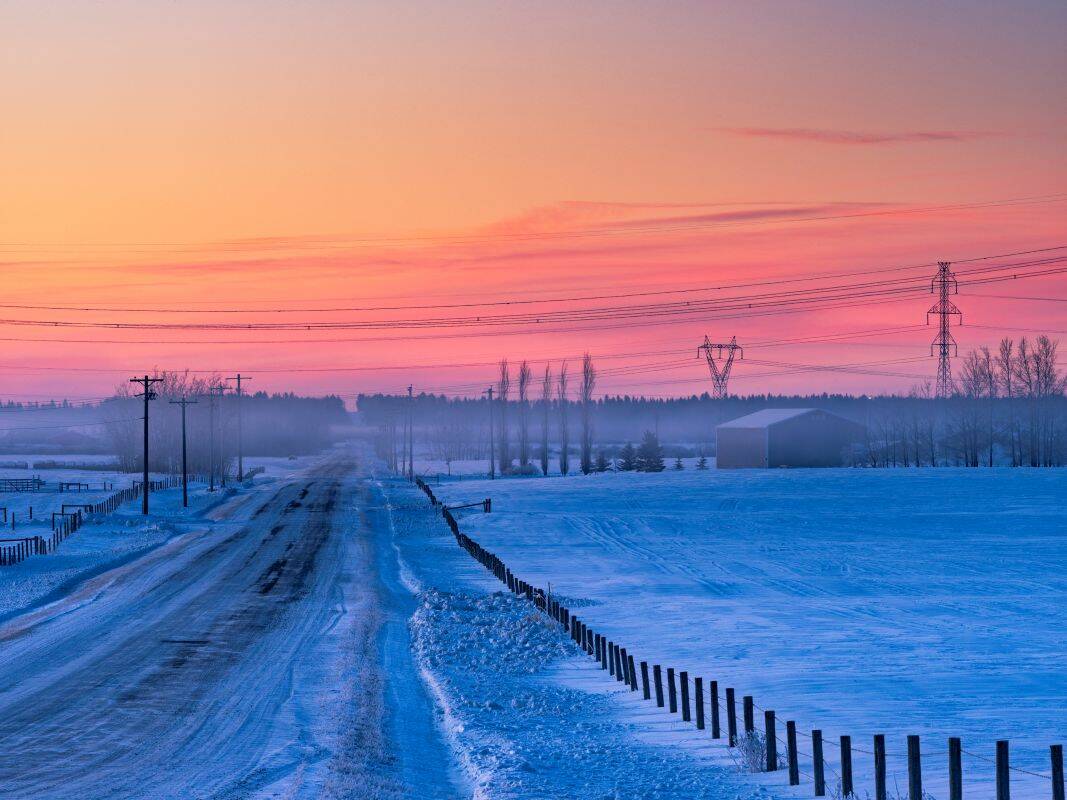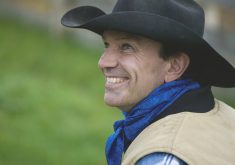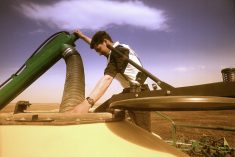For most of us, the sight of just one accident is all it takes to get us taking more reasonable precautions. So, imagine you are Krista Harris and you have seen what she has seen. As a career firefighter with over 20 years service with the Abbotsford Fire Department, Harris has attended innumerable motor vehicle accidents, fires and other incidents where people have been badly hurt or killed.
Last year she was among the first responders to farms in the flooded Fraser Valley, and she’s also been on the scene of numerous farm accidents, including fatalities.
“These incidents are gut wrenching,” she says.
Read Also

Winter downtime: Organize your farm records now for smoother operation
How to organize farm finances paperwork
Today, though, Harris also owns a farm, and it’s she and wife Cathy Van-Martin also a career firefighter who wonder: Could the next tragedy hit even closer?
Harris and Van-Martin and their three kids, along with Harris’s sister and brother in-law, who also have three children, plus Harris’s mother all live and farm together on the multi-generational farm near Abbotsford, an hour east of Vancouver, that they launched in 2017 with help from the BC Egg New Producer Program.
The decision to farm sprang from wanting their children to experience farm life, says Harris. They all have good off-farm jobs, but the farm is where they wanted their kids, who range in ages from seven to 25 years old, to grow up and experience all that farm life has to offer.
“And we absolutely hope that our children take over the farm some day,” she adds.
What these two families also want is for the farm to be the safest possible workplace both for themselves and those children. That was important from day one, especially with Harris and Van-Martin having spent their careers rescuing people in so many different kinds of unsafe situations — and knowing how things can go horribly wrong in an instant.
Most accidents she’s seen on farms were preventable, says Harris.
“It’s been interesting to be a fire fighter in an agricultural community and be exposed to farm accidents over the years of varying degree, from some sort of minor injury to some fatalities, and then all of sudden be a farmer,” she says. “You replay those accidents in your head and how many of them were preventable. Often it has to do with kids and having them milling about.”
Their own certainly are. Their kids love the farm, as do extended family members who visit and want to be involved in some way with it.
With that in mind, Harris and Van-Martin and the other couple have established the same safe work standards on their small farm that much larger commercial farms must adhere to under provincial occupational health and safety regulations.
“Our intentions are to meet all those safety standards,” says Harris. “We implement them here even though no one is coming in to inspect us. We feel it’s very important for ourselves.”
To do that, they developed a detailed safety plan for the farm after a thorough assessment of the risks they could proactively identify on the farm. They looked for hazards like rod conveyor systems and places where grates have been removed to facilitate speedier manure release from the barn. They set up standard operating procedures too, and rules for everyone to follow.

The youngsters know they are never to play at certain locations of the farm, and there is a list for everyone to abide by that responds to defined hazards. For instance, no one disables safety locks on hydraulics and everyone wears a respirator inside the free-run barn, where the hens tend to kick up a lot of dust, and much more.
Their safety plan also benefited from Van-Martin’s training in disaster emergency management. She created an emergency plan for the farm, with detailed “what to do if” guides and checklists.
“Flooding, fires, medical emergencies, bird health emergencies. We’ve got backup plans for all of this,” says Harris. “Numbers to call for anything that could impact the animals or people here … we have it all in one place.”
Perhaps most importantly, though, they are all 100 per cent committed to creating this safe work environment. No one person is specifically assigned to ensuring it’s maintained, says Harris. They all know what’s expected and they work together to meet those expectations.
“We have a team farming technique here, partially because we all have full-time jobs off the farm,” she says. “We are able to manage it with a community mentality, and (by) relying on each other.”
Harris would never call herself a safety expert, nor would any of the rest of their farm team. But together they have become safety advocates. Harris has taken that role even further by joining AgSafe BC on its board of directors. Farm safety will always be “something we think is extremely important,” she promises.
A safer grain farm
Near Enchant, across the border from the Harris farm and a couple of hours southeast of Calgary, Stamp Seeds is a very different family-owned farm, also with a strong culture of safety.
The family has been working the land here since 1978 when the farm was founded by Richard and Marian Stamp. Today the family operates as a pedigreed seed farm with their three sons Greg, Nathan and Matthew, each now married with a family of their own.
It’s a large, sophisticated operation on 7,000 acres with two dozen staff, comprising 16 full-time staff plus about eight seasonal.
Safety has always been important on their family’s farm, says Nathan Stamp, the farm’s operations and agronomy manager.
“My mom was always a big advocate for safety on the farm,” he says. “It was always something we grew up with.”

Today Stamp Seeds is very much a “farm of families” and it has become all that much more important that they focus on safe work procedures.
“When I came back to the farm we were doing a lot of the work ourselves, but as we got larger, we hired more people,” Stamp says. “I was always worried about what could happen, and thinking about where the areas were on the farm that we could improve as far as keeping people safe.”
By then, safe work practices had become second nature to him, something that was reinforced when he attended the University of Lethbridge and then when he became a certified crop advisor, which saw him go to numerous conferences and events where safe work was a frequent topic. As a summer student he worked for Dow Agrosciences, where safety was also integrated into the company’s day-to-day culture.
Stamp then brought that awareness back to the farm and began thinking about what more they could do to improve the work environment on the farm to reduce the risk of anyone getting injured.
“If I was uncomfortable doing a job on our farm, I didn’t want anyone else to feel unsafe doing it,” he says.
As a seed retail and certified chemical handling facility in Alberta, Stamp Seeds is required to meet provincial rules and regulations. They are audited annually to ensure the job sites have all the necessary safety measures in place, such as eye-wash stations, fire extinguishers and onsite emergency plans. They also ensure all their full-time employees receive first aid training and certification.
But having a safety culture on a farm goes beyond strictly following rules. Stamp Seeds was recognized during the 2020 Agricultural Safety Week campaign as a farm going the extra mile in its efforts to foster one.
Stamp says although everyone has a role to play, he tends to take the lead on the farm’s safety file. He’s the one ensuring that safe workplace procedures are gone over at the regular meetings their staff attend, and that those procedures are regularly reviewed. He will also see that any farm safety matters are raised at any other farm meetings.
Staff are always encouraged to speak up about any concerns they have such as near misses, or if they see a hazard that needs some attention, he says.
“We have everyone attend and go over near misses, or things that have happened since the last meeting, or items that could be improved, such as some kind of safety feature that could be improved,” he says.
This regular course of continuous reminder and check-in has value, says Stamp.
“It’s about trying to integrate a mindset,” he says. “You have to make it a priority … The big thing is being hands-on. You can’t go over it once and then expect a month later it’s going to stay with someone.”
This all ramps up when their extra staff join the team in the spring, too. Then there is safety training and orientation to co-ordinate.
It was this growing ethos of safety that prompted the Stamps to also introduce a health benefits plan for their workers. His spouse Christine did the legwork to get that introduced. This health plan was about taking regard for their workers another step further, he says.
“It comes back to the health of your employees, mentally and physically,” he says. They want a team that gets enough rest, has enough time off and isn’t pushed to overwork. Now, the implementation of their health plan provides access to funds to help their staff and families take care of themselves so they can do their jobs better.
“We’d never had a benefit package or a health plan, but we thought if we want to make this a place where people want to work and make a career out of it, we should offer items that other larger companies might have that appeal to employees.”

Adding it up
Are the kinds of safety measures that Krista Harris and Cathy Van-Martin in B.C. and Stamp Seeds in Alberta have committed to typical of how Canada’s farms are improving safety on their farms?
Experts on organizational behaviour, farm safety and workplace leadership would obviously like to say they are. And, certainly, there are signs of improvement. Statistics show that on-farm deaths and serious injuries from machine and animal-related mishaps are declining.
Better engineering has helped, says Dean Anderson, strategic advisor for agriculture with Workplace Safety and Prevention Services in Ontario, one of North America’s largest occupational health and safety organizations.
“Go back 30 years. How many tractors had a cab? Think of early equipment and how well-guarded chains and gears and belts used to be. Equipment is a lot safer,” he says.
Plus, there has been a huge investment in farm safety education by a wide range of farm-related organizations, and there’s much more awareness about the importance of safety.
However, there can still be big differences between farms.
A 2020 Farm Credit Canada survey done for the Canadian Agricultural Safety Association found most farmers are confident they do their jobs safely, but most also say their rules are unwritten. Written plans are less common.
Notably, the 1,200-farm survey found that a near miss didn’t necessarily change how a farmer does their work. Most farmers — 72 per cent — told the survey they’d had a close call. In fact, one in four had had something go amiss that very year.

Those numbers may hardly come as a surprise. Risk-taking behaviour is par for the course in agriculture.
Yet, the message farm safety teams and industry advocates keep hammering home is that most injuries are predictable and therefore preventable, as long as everyone on the farm team knows what to watch for.
There’s still plenty of pushback on regulating occupational health and safety standards on farms, even as farms generally remain less regulated than other industries. But there is a shift in mindset taking place too.
A new generation taking the helm has a different idea how farm work should get done, says Anderson. That’s because they’ve been coached throughout their lives about living and working in a safer environment, and it’s often part of their agricultural education. Often, too, they’ve worked in other industries where occupational health and safety is paramount.
These farmers see a safety program as an integral part of overall farm business planning and risk management. They also see safety as good for business. Obviously an injury can have severe business and financial consequences. Employees expect to work in safe workplaces.
“Good business people are thinking more about this,” Anderson says. “It’s getting there. The larger farms are there. That’s what I’ve seen in the last 20 years. It’s becoming part of the business plan and part of your risk management.”
However, no safety plan on the farm is worth anything if you aren’t actually following it yourself and if you don’t have a commitment to implementing it, says Anderson.
His best advice for anyone daunted by that, or even unconvinced that they need to organize a safer work space, is to tackle concerns one matter at a time. As the farm owner, you know what the key risks are and you know what you can do to reduce them, too.
“Bite off your safety program in chunks,” Anderson says. “Get rid of the big risks first, then keep working down the list.”
Morag Marjerison, a farm safety consultant with Keystone Agricultural Producers in Manitoba, has worked with hundreds of farmers over her career.
A formal safety plan is still relatively uncommon, she says. “But I have worked with farms of different sizes in terms of numbers of people, and there’s farms I know that have tried to formalize it.”
Approaches vary, she says. Some have one person designated to oversee a plan’s implementation, although she’s observed it can be a big job for one person.
Other farms establish a safety committee which, in Manitoba at least, is required by occupational health and safety legislation once the farm reaches a certain size.
“Here in Manitoba, if you have five or more workers around, you have to have one of the workers designated as a safety representative. If you have 20 or more you have to have a safety committee, made up of both managers or supervisor people plus employees,” Marjerison says. “When you get that big, it kind of fits naturally with forming these safety committees anyway.”
The challenge comes with smaller farms and farmers who don’t see a need to plan or change what they’ve been doing because “they’ve done it that way for years and nothing happened,” she says.
Her advice to them echoes Anderson’s.
“Make a start somewhere, anywhere,” Marjerison says. “Even if it’s just having a five-minute meeting with everyone on the farm asking ‘Has anyone seen anything on the farm we need to fix?’ Just try and start to make it a conversation. Then you can start to make small changes.”
Every farm thinks they’re safe, she says. Then, one day, too many discover they never were.















